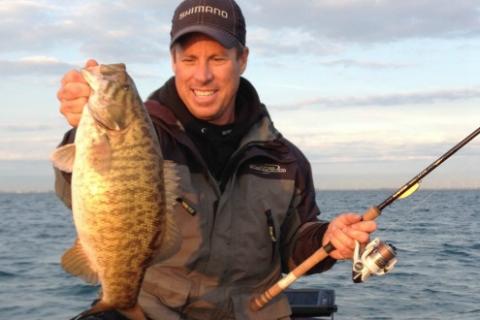
Derek Strub is one of Canada’s foremost authorities on all things smallmouth. Through years of experience, he’s identified a period in the fall when smallmouths will only key in on blade baits and jigging spoons. Once you dial them in, they’ll just about rip the rod out of your hands.
Much like spring, a prime feeding window opens once water temps delve into the low 40’s and low 50’ as fish will school up. As the water gets colder, the metabolism of smallmouth slow down considerably, yet they begin to attack fast moving reaction baits.
Track ‘Em Down
Strub first checks transitions and subtle rises on contour lines. He’ll use his Humminbird’s Side and 360 imaging to locate Great Lakes smallmouth that have started to slide off onshore structures to the deepest reaches or the points, eventually holding on the transitions of the farthest points. The deepest shorelines are not always on points, so smallmouth will transition from rock edges into softer material to winter.
“My 360 imaging shines more so, than any other time, when I’m fishing transitions because I can see ahead of the boat and be able fish directly on the transition and not stray to either side. Once I find larger schools, I’m going to use Minn Kota’s Spot Lock and pick them apart,” Strub said.
Dig ‘Em Out
Smallmouths are the most unpredictable of creatures—like belly down to the mud bizarre. “I’ve caught numerous smallmouth in the spring that have yet to pull up to spawn, with mud stuck to them,” Strub started. “I’ve also seen it too many times, when you get into late fall—early December and you’re catching fish on a jigging spoon or blade bait that aren’t even on the graph! Electronics are so good that you should be marking everything, but they won’t pick those fish up when they are belly down in the mud.”
One December day, Derek crushed smallmouth on blades in 55 feet but never marked one. He had smallmouth dialed in on a sloping contour line that stretched miles long and had more structure than most lakes have. The area consistently produces quality fish throughout the year, but as the season progresses, they will change their environment. He’d found them along edges that changed from gravel to boulders a week earlier, when he returned, they’d nestled into the mud adjacent to the boulders. On lakes where mud is not available, anglers should look for fish to slide off bigger structure to areas with a softer bottom.
Hook ‘Em Up
Strub’s found no bait more productive under such situation than the Bass Pro Shops XPS Lazer Blade or Tungsten jigging spoons in silver, gold, perch, and firetiger patterns. “Those two baits are very effective for covering water because regardless of whether you are in 35- to 60- feet, a ¾-ounce spoon or blade will get to the bottom quickly and much more effective than any other bait.”
Strub prefers to drop his bait to the bottom, let it lie on slack line, and then stand it up. Always let the fish determine the cadence if you’re not getting bit. Sometimes, smallmouth will want the spoon snapped aggressively while other times the slightest flick of the wrist can trigger a bite.
Reel ‘Em In
If it’s calm, he’ll fish a ½-ounce spoon on spinning gear and braided line with a fluorocarbon leader. For larger baits, he prefers a high-speed baitcaster, like a Shimano Chronarch Ci4+ spooled with 15-pound Power Pro Super Slick 8 and a 15-pound fluorocarbon leader. While he prefers a 6-10 medium-heavy action rod, he stresses that the rod has to have some tip to not only work the bait properly but to allow the fish to grab the bait with minimal resistance as it’s being worked. Most strikes will occur while the bait is falling on a slack line.
He’ll keep a hook file nearby to touch up the hooks after get snagged or banged off rocks. A couple of missed fish serve as a good reminder to touch up your hook-points. Strub bucks the common trend of upsizing the hooks on his baits as he finds they’ll get tangled up more, but he does prefer trebles with extra-wide gaps for better hooking.
After hooking enough good numbers of fish, they may shut-off. You best fire up your outboard and go looking for the next wolf-pack!
- 3986 views

